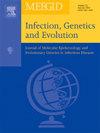Pneumococcal transposon profiling associated with macrolide, tetracycline, and chloramphenicol resistance from carriage isolates of serotype 19F in Indonesia
IF 2.6
4区 医学
Q3 INFECTIOUS DISEASES
引用次数: 0
Abstract
Genetic evolution of resistance due to mutations and transposon insertions is the primary cause of antimicrobial resistance in Streptococcus pneumoniae. Resistance to macrolide, tetracycline, and chloramphenicol is caused by the insertion of specific genes that carried by transposon (Tn). This study aims to analyze transposon profiling associated with macrolide, tetracycline, and chloramphenicol resistance from carriage isolates of S. pneumoniae serotype 19F in Indonesia. S. pneumoniae serotype 19F isolates were collected from nasopharyngeal swab specimens from different regions in Indonesia. Genomic DNA was extracted from sixteen isolates and whole genome sequencing was performed on Illumina platform. Raw sequence data were analyzed using de novo assembly by ASA3P and Microscope server. The presence of transposons was identified with detection of int and xis genes and visualized by pyGenomeViz. The genome size of S. pneumoniae ranges from 2,040,117 bp to 2,437,939 bp, with a GC content of around 39 %. ST1464 (4/16) and ST271 (3/16) were found as the predominant sequence type among isolates. Tn2010 was the most common transposon among S. pneumoniae serotype 19F isolates (7/16) followed by Tn2009 (4/16), and Tn5253 (3/16). We identified two deletion sites within the tetM gene (2 bp and 58 bp) that confer tetracycline susceptibility from one isolate. This study suggests that genomic analysis can be employed for the detection and surveillance of antimicrobial resistance genes among S. pneumoniae strains isolated from various regions in Indonesia.
从印度尼西亚血清型 19F 的携带分离物中分析与大环内酯类、四环素类和氯霉素耐药性相关的肺炎球菌转座子。
基因突变和转座子插入导致的耐药性基因进化是肺炎链球菌产生抗菌药耐药性的主要原因。对大环内酯类、四环素类和氯霉素的耐药性是由转座子(Tn)携带的特定基因插入引起的。本研究旨在分析印度尼西亚肺炎双球菌血清型 19F 携带分离物中与大环内酯类、四环素类和氯霉素耐药性相关的转座子图谱。肺炎双球菌血清型 19F 分离物是从印度尼西亚不同地区的鼻咽拭子标本中采集的。从 16 个分离株中提取了基因组 DNA,并在 Illumina 平台上进行了全基因组测序。使用 ASA3P 和 Microscope 服务器对原始序列数据进行了分析。通过检测 int 和 xis 基因确定了转座子的存在,并通过 pyGenomeViz 进行了可视化。肺炎双球菌的基因组大小从 2,040,117 bp 到 2,437,939 bp 不等,GC 含量约为 39%。ST1464(4/16)和 ST271(3/16)是分离株中最主要的序列类型。Tn2010 是肺炎双球菌血清型 19F 分离物中最常见的转座子(7/16),其次是 Tn2009(4/16)和 Tn5253(3/16)。我们从一个分离株中发现了 tetM 基因中的两个缺失位点(2 bp 和 58 bp),这两个缺失位点赋予了分离株对四环素的敏感性。这项研究表明,基因组分析可用于检测和监控从印度尼西亚不同地区分离的肺炎双球菌菌株的抗菌药耐药性基因。
本文章由计算机程序翻译,如有差异,请以英文原文为准。
求助全文
约1分钟内获得全文
求助全文
来源期刊

Infection Genetics and Evolution
医学-传染病学
CiteScore
8.40
自引率
0.00%
发文量
215
审稿时长
82 days
期刊介绍:
(aka Journal of Molecular Epidemiology and Evolutionary Genetics of Infectious Diseases -- MEEGID)
Infectious diseases constitute one of the main challenges to medical science in the coming century. The impressive development of molecular megatechnologies and of bioinformatics have greatly increased our knowledge of the evolution, transmission and pathogenicity of infectious diseases. Research has shown that host susceptibility to many infectious diseases has a genetic basis. Furthermore, much is now known on the molecular epidemiology, evolution and virulence of pathogenic agents, as well as their resistance to drugs, vaccines, and antibiotics. Equally, research on the genetics of disease vectors has greatly improved our understanding of their systematics, has increased our capacity to identify target populations for control or intervention, and has provided detailed information on the mechanisms of insecticide resistance.
However, the genetics and evolutionary biology of hosts, pathogens and vectors have tended to develop as three separate fields of research. This artificial compartmentalisation is of concern due to our growing appreciation of the strong co-evolutionary interactions among hosts, pathogens and vectors.
Infection, Genetics and Evolution and its companion congress [MEEGID](http://www.meegidconference.com/) (for Molecular Epidemiology and Evolutionary Genetics of Infectious Diseases) are the main forum acting for the cross-fertilization between evolutionary science and biomedical research on infectious diseases.
Infection, Genetics and Evolution is the only journal that welcomes articles dealing with the genetics and evolutionary biology of hosts, pathogens and vectors, and coevolution processes among them in relation to infection and disease manifestation. All infectious models enter the scope of the journal, including pathogens of humans, animals and plants, either parasites, fungi, bacteria, viruses or prions. The journal welcomes articles dealing with genetics, population genetics, genomics, postgenomics, gene expression, evolutionary biology, population dynamics, mathematical modeling and bioinformatics. We also provide many author benefits, such as free PDFs, a liberal copyright policy, special discounts on Elsevier publications and much more. Please click here for more information on our author services .
 求助内容:
求助内容: 应助结果提醒方式:
应助结果提醒方式:


